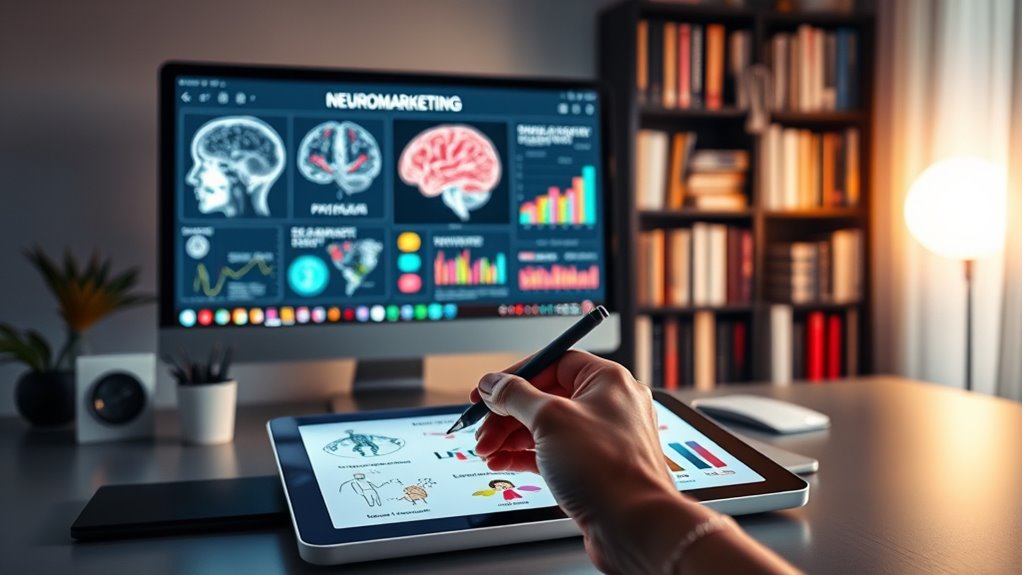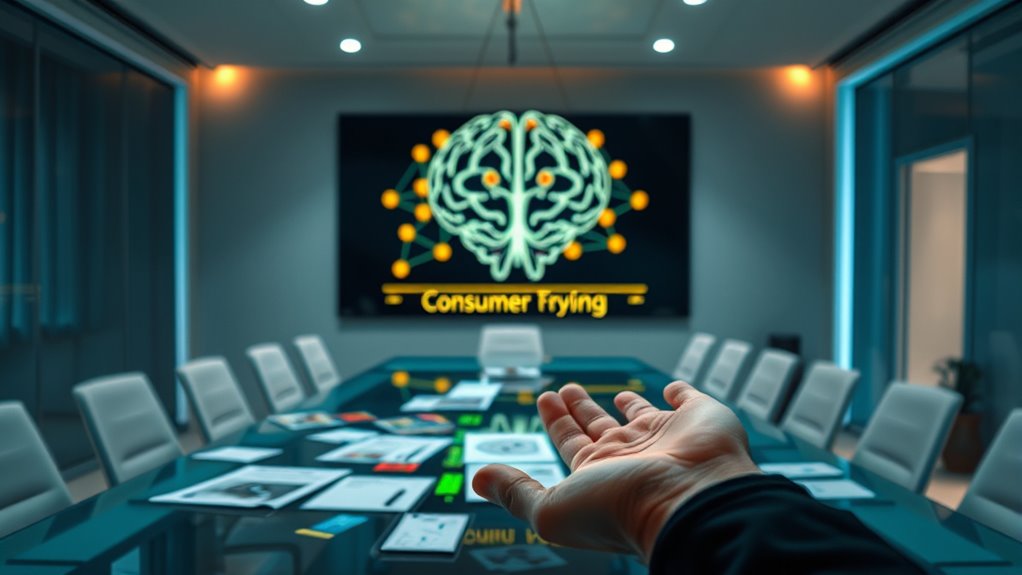Understanding consumer psychology is key to crafting effective digital strategies. Emotions strongly influence buying decisions, often more than rational thought, and marketers use emotional triggers, visuals, and colors to evoke specific responses. Recognizing how the brain processes images and cues helps you design engaging content that builds trust and loyalty. Ethical practices and data insights guarantee your approach respects consumers while maximizing impact. Keep exploring to uncover how these principles can turn your digital efforts into powerful connections.
Key Takeaways
- Neuromarketing leverages insights into consumer emotions and subconscious responses to optimize digital content and engagement strategies.
- Understanding how visual cues, colors, and facial expressions activate neural pathways helps craft more compelling marketing messages.
- Emotional triggers influence decision heuristics, guiding consumers toward specific actions and brand loyalty online.
- Data from neuroimaging and behavioral tracking reveal subconscious preferences, enabling personalized digital marketing approaches.
- Ethical considerations in neuromarketing ensure consumer privacy while applying psychological insights responsibly for effective strategies.
The Role of Emotions in Consumer Decision-Making

Emotions play a crucial role in shaping your purchasing choices because they often influence decisions more than rational analysis. When you encounter a product or service, emotional triggers like happiness, fear, or excitement can override logical reasoning. These triggers activate decision heuristics—mental shortcuts that simplify complex choices—making it easier for you to decide quickly. For example, feeling nostalgic might prompt you to buy a vintage item, while fear of missing out pushes you toward impulsive purchases. Marketers harness these emotional triggers to create strong connections, encouraging you to act without overthinking. Recognizing how emotions influence your decisions can help you become more aware of subconscious biases and make more intentional choices. Additionally, understanding consumer psychology can reveal why certain marketing tactics are so effective, enabling you to better resist manipulative strategies. Moreover, brand associations generated through emotional marketing can significantly impact your loyalty and perception of a product. Emotions also activate specific decision heuristics, which are mental shortcuts that guide your behavior in complex situations, making it easier to choose certain products over others. Some emotional responses are reinforced through relationship building tactics, fostering a deeper connection between you and brands, which further influences your purchasing habits. Furthermore, recognizing the influence of emotional responses can empower you to make more balanced and informed decisions, rather than being driven solely by impulse or subconscious cues. Emotions, consequently, serve as powerful drivers behind many consumer behaviors.
How the Brain Processes Visual Content

When you see an image, your brain’s visual cortex springs into action, quickly processing shapes and patterns. Colors can influence your emotions and attention almost instantly, guiding your focus and reactions. Recognizing familiar images happens in the blink of an eye, allowing for rapid decision-making and emotional responses. Additionally, mammography guidelines emphasize the importance of early detection through visual imaging techniques to improve treatment outcomes. Understanding how visual processing works helps in designing compelling visual content that captures attention and influences consumer behavior effectively. Recognizing the role of neural pathways in visual perception further enhances our ability to craft effective marketing visuals that resonate with viewers, as neuroplasticity allows the brain to adapt and optimize responses to visual stimuli over time. Moreover, yarn yardage calculations can be compared to how the brain estimates the amount of visual information needed to create impactful content, ensuring optimal engagement.
Visual Cortex Activation
The visual cortex is the brain’s primary area for processing visual information, and it activates almost instantly when you see an image or a scene. This activation involves complex neural pathways that rapidly interpret shapes, patterns, and details. When you view compelling visuals, your visual cortex works to decode these signals, influencing your emotional and cognitive responses. Additionally, the efficiency of this process can be enhanced by visual complexity, which determines how easily the brain can interpret the visual data. Understanding this process helps marketers craft images that trigger quick, positive reactions. For example, high-quality resolution enhances the clarity and detail, making visuals more engaging and easier for the brain to process efficiently. Moreover, the brain’s ability to quickly analyze visual content is supported by the neurological pathways, which facilitate rapid interpretation and response. The timing of visual presentation also plays a crucial role in ensuring the brain processes images optimally for marketing impact. Incorporating visual hierarchy into designs can further streamline how the brain prioritizes visual elements, improving overall effectiveness.
Color Impact Effects
Colors in visual content can strongly influence how your brain perceives and responds to an image. This is where color psychology plays a pivotal role, as different hues evoke specific emotional and behavioral reactions. Your brain processes hue perception quickly, attaching meaning based on cultural associations and personal experiences. For example, red can stimulate excitement or urgency, while blue often promotes trust and calmness. Understanding these responses helps you craft visuals that align with your message and desired consumer behavior. By strategically choosing colors, you influence subconscious reactions, guiding viewers toward your call to action. Remember, color impact effects aren’t just about aesthetics—they’re powerful tools that tap into your audience’s instinctive responses, making your digital strategy more effective and engaging. Embracing an awareness of creative practice can also inspire innovative visual choices that resonate deeply with viewers. Additionally, being mindful of cultural associations related to color can enhance your content’s effectiveness across diverse audiences. Recognizing the importance of emotional triggers can further refine how you use color to evoke specific feelings and drive engagement. Moreover, understanding the AI-driven analytics behind consumer responses can help optimize your visual strategy for better engagement.
Image Recognition Speed
Have you ever wondered how quickly your brain can identify and interpret visual content? It’s surprisingly fast—often within milliseconds. Your brain rapidly processes image speed, allowing you to recognize faces, facial expressions, and emotions almost instantly. This rapid recognition influences your emotional response and decision-making. Expert voice actors often utilize this understanding to craft compelling audio-visual content that resonates instantly with viewers. Additionally, understanding the mechanisms behind visual processing speed can help marketers design more effective content that captures attention immediately. Moreover, recent studies highlight how neuroscience insights into visual perception can be applied to optimize marketing visuals for maximum impact. Recognizing the importance of visual cognition can improve how visual messages are crafted to increase engagement. For example, studies show that the presence of facial cues makes images more memorable and impactful. Key points include: – Facial expressions are identified in under 100 milliseconds, triggering immediate emotional reactions. – The brain prioritizes images with strong facial cues, making them more memorable. – Fast image processing helps you quickly assess visual content, essential for effective digital marketing. Understanding this speed helps you optimize visual content for your audience, ensuring images and facial expressions communicate your message instantly. When you leverage rapid recognition, your marketing strategy becomes more compelling and emotionally engaging.
The Influence of Colors on Consumer Behavior

Ever wondered how a simple shade can influence your purchasing decisions? That’s the power of color psychology at work. Different hues carry distinct psychological meanings that can trigger specific emotions and behaviors. For example, red often stimulates urgency and excitement, making it ideal for clearance sales. Blue tends to evoke trust and reliability, perfect for financial or healthcare brands. Green is associated with health and sustainability, appealing to eco-conscious consumers. The hue influence extends beyond just choosing a color; it shapes how you perceive a brand or product instantly. By understanding these subtle cues, you can craft digital strategies that resonate more deeply with your audience, guiding their decisions without them even realizing it. Color psychology isn’t just decoration — it’s a critical marketing tool. Additionally, incorporating protective styling benefits into your visual branding can enhance consumer trust by emphasizing product durability and care. Recognizing the influence of zodiac signs on personality traits can also help tailor personalized marketing approaches, creating a more engaging consumer experience.
The Power of Storytelling in Marketing

Storytelling holds immense power in marketing because it creates an emotional connection that captures your audience’s attention and keeps them engaged. When you use effective storytelling techniques, you tap into your audience’s emotions, making your message memorable. Narrative engagement encourages your audience to see themselves in your story, fostering trust and loyalty. To maximize impact, focus on:
- Crafting compelling characters that resonate emotionally
- Using vivid visuals and relatable scenarios
- Building a clear, authentic narrative arc
These elements help your message stand out and deepen consumer engagement. When your storytelling resonates, it influences decision-making and strengthens brand loyalty. By prioritizing storytelling techniques that evoke emotion, you turn passive viewers into active participants in your brand story.
Sensory Marketing and Its Impact on Engagement

You can instantly influence how customers feel by using visual stimuli that grab attention and evoke emotions. Soundscapes also shape moods, making shoppers more receptive to your message. Tactile engagement adds a memorable layer, encouraging interaction and deeper connection with your brand.
Visual Stimuli Effects
Visual stimuli play a crucial role in sensory marketing by capturing attention and influencing consumer perceptions instantly. Your brain’s visual perception quickly processes image aesthetics, shaping how you view products and brands. Effective visual stimuli can evoke emotions, making your experience more memorable and engaging. When designing digital content, focus on creating appealing visuals that align with your target audience’s preferences. Clear, attractive images can boost interaction and brand recall by triggering positive associations. To maximize impact, consider color schemes, layout, and visual harmony that resonate emotionally. Remember, your subconscious responds deeply to visual cues, influencing your decision-making process without you realizing it. Incorporating compelling visual stimuli helps you connect with consumers on a sensory level, making your digital strategy more persuasive and effective.
Sound and Mood Influence
Have you ever noticed how certain sounds in a store or app can instantly influence your mood and behavior? That’s the power of soundscapes influence your experience through mood regulation. Carefully curated sounds can evoke feelings of calm, excitement, or trust, guiding your emotional response without you realizing it. For businesses, this means using background music or ambient noise strategically to enhance engagement and create a welcoming atmosphere. When soundscapes align with brand goals, they support consumer decision-making and foster positive associations. By understanding how sound influences mood, you can design environments—digital or physical—that keep customers engaged and comfortable, ultimately increasing loyalty and satisfaction. Sound and mood regulation are essential tools in shaping consumer psychology and boosting your digital strategy’s effectiveness.
Tactile Engagement Power
While sound influences how you feel and behave, tactile engagement takes that connection a step further by activating your sense of touch. Tactile feedback enhances your experience by making products feel more real and engaging. When you interact with textures, your perception of quality and value sharpens, encouraging you to connect more deeply with a brand. Texture perception plays a pivotal role in shaping your emotional response and trust. To maximize tactile power, brands often incorporate textured packaging, interactive displays, and soft-touch finishes. These elements stimulate your tactile senses, heightening engagement and satisfaction. By leveraging tactile feedback, you not only feel more connected but also develop stronger brand loyalty. This sensory approach turns simple interactions into memorable experiences that influence buying decisions.
Cognitive Biases That Drive Purchasing Choices

Understanding cognitive biases is essential because they profoundly influence how you make purchasing decisions. Heuristic shortcuts allow you to simplify complex choices quickly, often leading you to favor familiar brands or options that seem safer. Framing effects also play a significant role; the way information is presented can sway your perception of value or quality. For example, highlighting discounts or emphasizing scarcity can make an offer appear more attractive, prompting faster decisions. Recognizing these biases helps you see how marketers subtly guide your choices without you realizing it. By understanding these mental shortcuts and framing influences, you become more aware of your own decision-making process, enabling you to make more deliberate, less impulsive purchases.
The Significance of Trust and Credibility

Building authenticity online helps you establish trust with your audience from the start. Using clear visual cues and signals reinforces your credibility and reassures potential customers. Consistent branding practices guarantee your message remains reliable and memorable across all touchpoints.
Building Authenticity Online
Establishing authenticity online is essential because consumers increasingly rely on digital interactions to determine trustworthiness. When your brand practices transparency, it shows you’re honest and open, which builds credibility. Influencer authenticity also plays a key role; followers trust genuine voices over scripted endorsements. To strengthen your online authenticity, consider these strategies:
- Share behind-the-scenes content to showcase transparency.
- Collaborate with influencers who genuinely align with your brand values.
- Respond openly to customer feedback to demonstrate honesty and commitment.
Visual Cues and Signals
Visual cues and signals serve as powerful tools to convey trust and credibility instantly. Your website’s visual hierarchy guides visitors’ attention, highlighting key messages and building confidence. Facial expressions in images or videos subtly communicate sincerity and openness, reinforcing authenticity. When you use clear, well-organized visuals, you enhance perceived credibility and foster trust.
| Visual Element | Impact on Trust |
|---|---|
| Facial expressions | Convey warmth, sincerity |
| Visual hierarchy | Prioritizes important info, reduces confusion |
| Consistent cues | Reinforces reliability and professionalism |
Consistent Branding Practices
Have you ever wondered why consistent branding boosts trust and credibility? When your brand maintains a steady visual identity, customers recognize and feel confident in your message. Brand consistency reassures consumers, making them more likely to choose you over competitors. It also helps establish a strong emotional connection, fostering loyalty. To build trust through consistent branding practices, focus on:
- Using uniform colors, fonts, and logos across all platforms
- Ensuring messaging aligns with your brand’s core values
- Maintaining a cohesive tone and style in content and visuals
Neuromarketing Techniques for Digital Content

To effectively capture attention online, leveraging neuromarketing techniques for digital content involves understanding how the brain responds to various stimuli. Techniques like brainwave entrainment can synchronize your audience’s brainwaves, making content more engaging and memorable. Subliminal messaging subtly influences subconscious thoughts, guiding choices without awareness. Using these methods, you can heighten emotional responses and increase conversions. Below is a table illustrating key techniques:
| Technique | Purpose |
|---|---|
| Brainwave entrainment | Enhance focus, relaxation, or alertness |
| Subliminal messaging | Influence attitudes subtly |
| Visual stimuli | Trigger emotional reactions |
| Color psychology | Influence mood and behavior |
| Sound design | Reinforce branding and message |
Understanding the Customer’s Brain Through Data

Harnessing neuromarketing techniques enhances your ability to influence consumers’ subconscious responses, but understanding how your audience’s brains process information requires a data-driven approach. By analyzing neural pathways and cognitive mapping, you can uncover how your customers’ brains connect ideas, emotions, and behaviors. This insight helps you craft content that resonates on a deeper level.
Understanding neural pathways reveals how consumers connect ideas, emotions, and behaviors for more impactful marketing.
Consider these key strategies:
- Use neuroimaging data to identify active neural pathways during decision-making.
- Map cognitive associations to align your messaging with subconscious triggers.
- Track behavioral responses to refine your understanding of what influences your audience.
This approach allows you to decode how your customers’ brains interpret your content, enabling more targeted and effective digital strategies that tap into the core of consumer psychology.
Ethical Considerations in Neuromarketing

What ethical boundaries should you consider when applying neuromarketing techniques? You need to address privacy concerns, ensuring consumers’ data isn’t misused or exploited. Respect their right to privacy by being transparent about how data is collected and analyzed. Informed consent is critical; you must clearly explain what participants agree to and how their responses will influence marketing strategies. Avoid manipulative tactics that could deceive or pressure consumers into decisions they wouldn’t make voluntarily. Maintain honesty and integrity, prioritizing consumer autonomy over aggressive persuasion. By setting these boundaries, you build trust and uphold ethical standards in neuromarketing, ensuring your strategies are responsible and respectful of individual rights.
Frequently Asked Questions
How Does Neuromarketing Differ From Traditional Market Research?
You might wonder how neuromarketing differs from traditional market research. Unlike traditional methods, neuromarketing focuses on your brain response and emotional triggers, revealing subconscious reactions you might not be aware of. It uses tools like EEG or fMRI to measure emotional engagement directly. This approach helps you understand deeper consumer motives, enabling more effective strategies by tapping into the subconscious mind, rather than relying solely on explicit feedback or surveys.
Can Neuromarketing Techniques Be Personalized for Individual Consumers?
Imagine you visit a website, and it instantly shows you products tailored to your preferences—this is personalized targeting through consumer profiling. Neuromarketing techniques can indeed be customized for individual consumers, using data like brain responses and emotional triggers. By analyzing these insights, brands craft unique experiences, making your engagement more effective. So, yes, neuromarketing can be personalized, enhancing how you connect with products and services.
What Are the Legal Regulations Surrounding Neuromarketing Practices?
You need to understand that legal regulations around neuromarketing focus on protecting consumer rights. You must obtain informed consent before collecting any neural or behavioral data. Data privacy laws also require you to securely store and handle sensitive information, ensuring transparency. Failing to adhere to these regulations can lead to legal penalties. Always prioritize ethical practices to respect consumer autonomy and maintain trust in your marketing efforts.
How Measurable Are the Results of Neuromarketing Strategies?
Imagine trying to measure how many angels dance on a pinhead—welcome to evaluating neuromarketing results. The factors influencing measurability include subtle brain responses and emotional triggers, making quantification a challenge. While tools like fMRI and EEG give insights, they often fall short of perfect accuracy. So, you’ll find that measuring neuromarketing’s success is more art than science, with plenty of room for interpretation and uncertainty.
What Are the Potential Risks of Overusing Neuromarketing Tactics?
You should be aware that overusing neuromarketing tactics can lead to ethical concerns, especially around consumer manipulation. If you rely too heavily on subconscious triggers, you risk crossing ethical boundaries and eroding trust. Overdoing it might make your audience feel manipulated, damaging your brand’s reputation. Balance is key—use neuromarketing responsibly to avoid ethical pitfalls and guarantee your strategies respect consumer autonomy.
Conclusion
By mastering these neuromarketing basics, you can decipher the secret code to consumer minds and exponentially boost your digital strategy. When you harness emotions, colors, storytelling, and trust, you create an irresistible experience that captivates and convinces. Remember, understanding your audience’s brain is like possessing a superpower—use it wisely and watch your engagement skyrocket beyond your wildest dreams. Embrace these techniques, and your marketing will become an unstoppable force!










